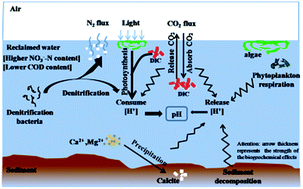Abnormal pH elevation in the Chaobai River, a reclaimed water intake area†
Abstract
The pH is a primary index reflecting water quality in rivers. The Jian River and Chaobai River are two reclaimed water intake areas which have elevated pH. This elevated pH has a marked effect on both the phytoplankton, species in water and vegetation on the shore. Understanding the main reasons causing pH elevation in river water has important implications for river ecosystem management and the improvement of water quality and can provide a theoretical basis for the direction of water quality improvement. For this reason, each biogeochemical and physical process influencing pH changes in water was quantified along the flow direction in the Wenyu to Chaobai reclaimed water diversion project, in which proton consumption and production by such processes were monitored and calculated at five monitoring sections. The calculations indicated that photosynthesis and denitrification were the primary reasons for the increase of pH in the Jian River and Chaobai River. Oppositely, carbonate precipitation and sediment decomposition restricted the increase of pH in both rivers. In addition, CO2 emission to the air also promoted a increase of pH in the Jian River, while CO2 absorption from the air restricted the increase of pH in the Chaobai River. NO3− nitrogen in reclaimed water was not efficiently removed and the reclaimed water flow condition in the intake area created favorable conditions for photosynthesis of algae breeding and denitrification by microorganisms. Therefore, biogeochemical and physical processes that promoted the increase of pH were greater than inhibiting processes and the pH gradually increased along the flow direction. The contribution rates of photosynthesis and denitrification for the increase of pH were 55.48 and 27.09%, respectively, in the Jian River and 78.08 and 21.92%, respectively, in the Chaobai River. In addition, CO2 emission contributed 17.43% of the increase in pH in the Jian River.


 Please wait while we load your content...
Please wait while we load your content...